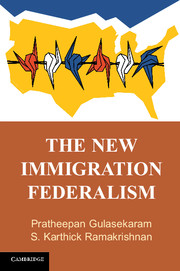Book contents
- Frontmatter
- Dedication
- Contents
- List of Figures and Tables
- Acknowledgments
- 1 Introduction
- 2 Setting the Stage for the New Immigration Federalism
- 3 Rise of Restrictive Legislation and Demographic Arguments of “Vital Necessity”
- 4 A Political Theory of Immigration Federalism: The Polarized Change Model and Restrictive Issue Entrepreneurs
- 5 A Shifting Tide in 2012: Pro-Integration Activists Gain the Upper Hand
- 6 Implications for Legal Theory on Federalism and Immigration Law
- 7 Immigration Federalism Is Here To Stay
- Appendix A Statistical Analysis of Restrictive Local Ordinances
- Appendix B Statistical Analysis of Restrictive State Laws
- Appendix C Statistical Analysis of State Immigrant Integration Laws
- Notes
- Index
Appendix B - Statistical Analysis of Restrictive State Laws
Published online by Cambridge University Press: 05 November 2015
- Frontmatter
- Dedication
- Contents
- List of Figures and Tables
- Acknowledgments
- 1 Introduction
- 2 Setting the Stage for the New Immigration Federalism
- 3 Rise of Restrictive Legislation and Demographic Arguments of “Vital Necessity”
- 4 A Political Theory of Immigration Federalism: The Polarized Change Model and Restrictive Issue Entrepreneurs
- 5 A Shifting Tide in 2012: Pro-Integration Activists Gain the Upper Hand
- 6 Implications for Legal Theory on Federalism and Immigration Law
- 7 Immigration Federalism Is Here To Stay
- Appendix A Statistical Analysis of Restrictive Local Ordinances
- Appendix B Statistical Analysis of Restrictive State Laws
- Appendix C Statistical Analysis of State Immigrant Integration Laws
- Notes
- Index
Summary
For Table B.1, we came up with a measure of state-level legislative activity on immigrant integration based on reports from the National Conference of State Legislatures from 2005, 2006, and 2007, and included any measures that bear a significant relationship to illegal immigration. Two graduate research assistants were instructed to code the bills on an ordinal scale of 1: “low impact” and 2: “high impact” on immigrant rights and/or access to benefits. These categories were drawn based on the provision's likely effects on immigrant life chances and the number of immigrants likely to be affected. Since these two categories offered a stark distinction, inter-coder reliability was 94 percent. In the cases where two codes conflicted, the principal investigator provided the tie-breaking vote. The dependent variable is no major laws, one major law, and two or more major laws. We model the results as an ordered logistic regression, which is appropriate when outcomes take on 3 or more ordinal values.
For Table B.2, we also measured state policies on enforcement and employer mandates, as of January 2012, using a database from Findlaw. Factor analyses revealed that these two measures represented one underlying factor. We use an Ordinary Least Squares (OLS) estimator, given that the outcome is a continuous (non-dichotomous) variable, and present the results as standardized coefficients.
- Type
- Chapter
- Information
- The New Immigration Federalism , pp. 209 - 210Publisher: Cambridge University PressPrint publication year: 2015



